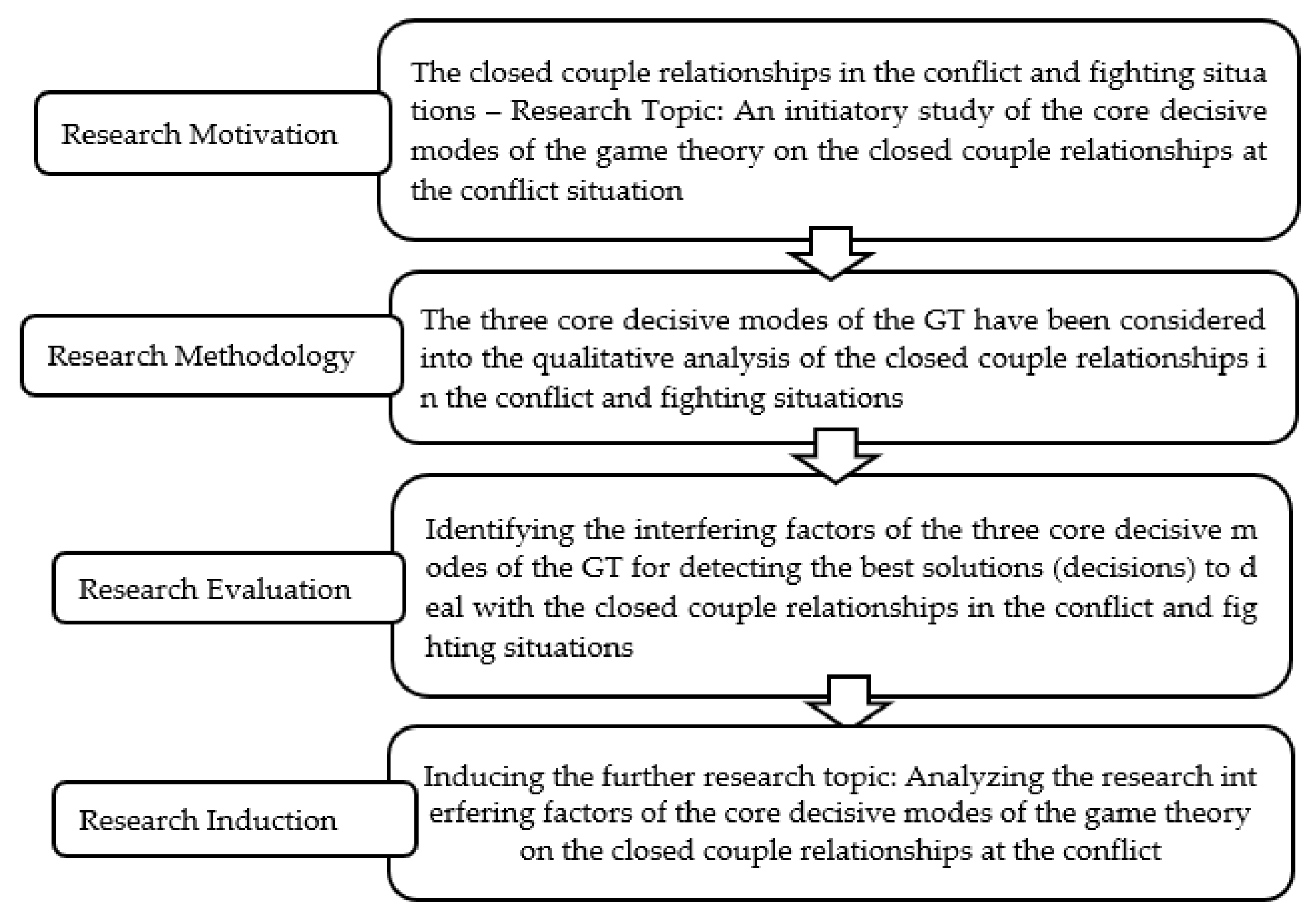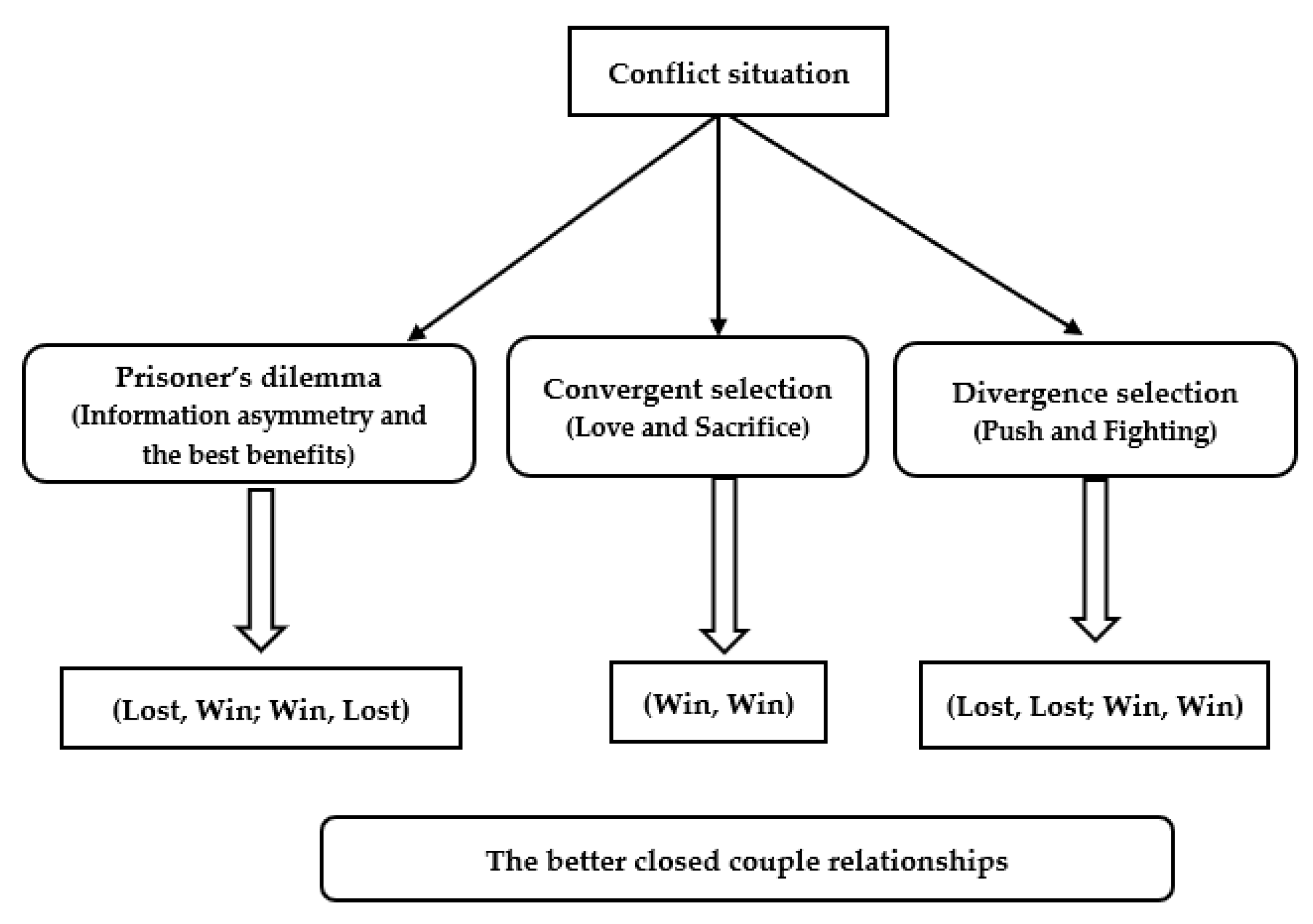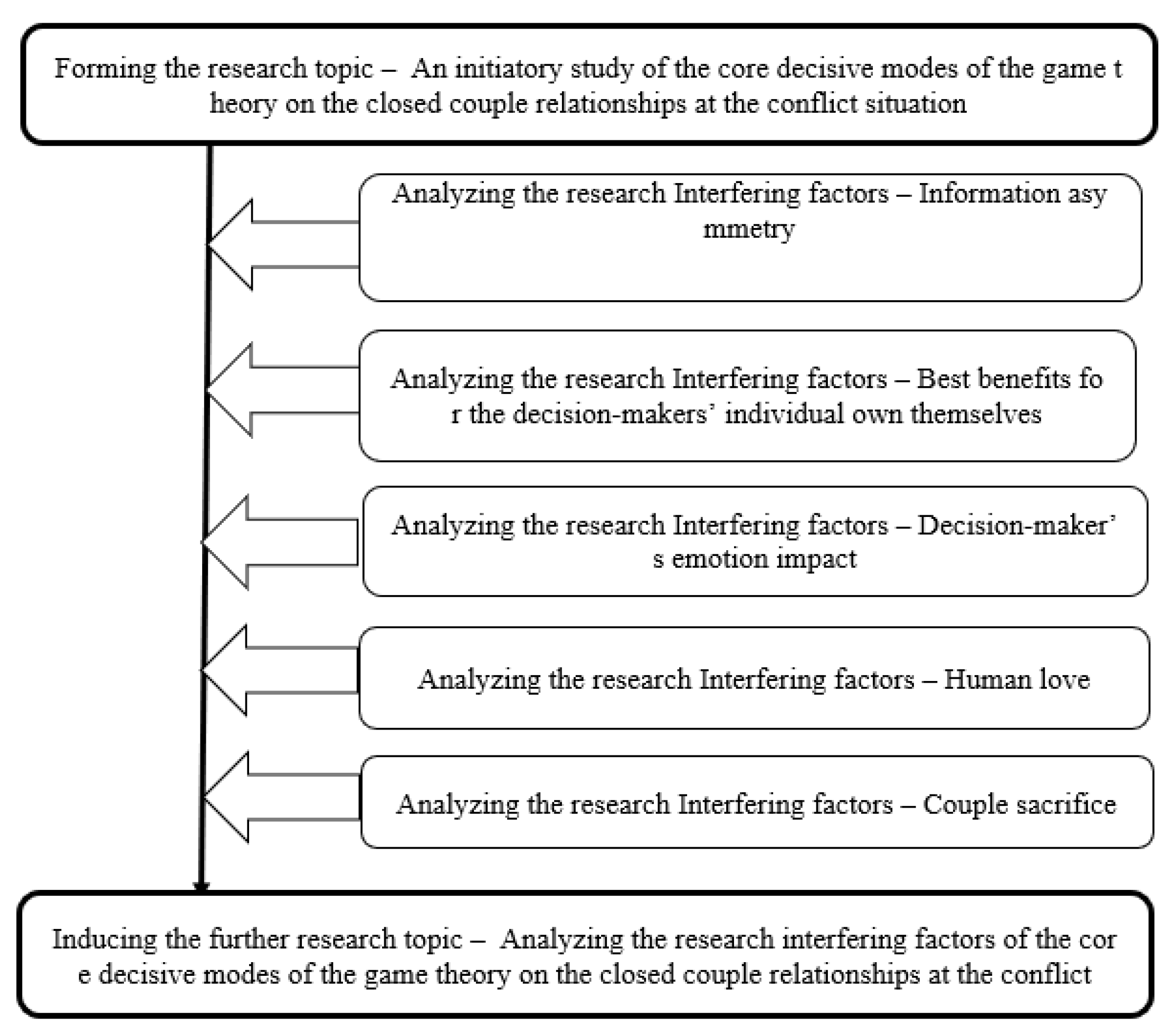Initial Study of Core Decisive Modes of Game Theory on Closed Couple Relationships in Conflict Situations †
Abstract
1. Introduction
2. Literature Review
3. Research Method
4. Results and Discussion
5. Conclusions and Recommendations
Author Contributions
Funding
Institutional Review Board Statement
Informed Consent Statement
Data Availability Statement
Conflicts of Interest
References
- Nash, J.F., Jr. Equilibrium points in n-person games. Mathematics 1950, 36, 48. [Google Scholar]
- Nash, J.F., Jr. The bargaining problem. Econometria 1950, 18, 155. [Google Scholar] [CrossRef]
- Nash, J.F., Jr. Non-cooperative games. Ann. Math. 1951, 54, 286. [Google Scholar] [CrossRef]
- The Concise Encyclopedia of Economics: Prisoners’ Dilemma. Available online: http://www.econlib.org/library/Enc/PrisonersDilemma.html (accessed on 12 May 2023).
- Robinson, J. An iterative method of solving a game Ann. Math 1951, 54, 296. [Google Scholar]
- Huang, C.C.; Chan, Y.-K.; Hsieh, M.Y. The Determinants of ESG for Community LOHASism Sustainable Development Strategy. Sustainability 2022, 14, 11429. [Google Scholar] [CrossRef]
- Chan, Y.-K.; Hsieh, M.Y. An Empirical Study on Higher Education C-ESG Sustainable Development Strategy in Lower-Birth-Rate Era. Sustainability 2022, 14, 12629. [Google Scholar] [CrossRef]
- Hsieh, M.Y. The Sustainable Development and Strategic Approaches for Contemporary Higher Education. Sustainability 2022, 14, 12925. [Google Scholar] [CrossRef]
- Huang, C.-C.; Chan, Y.-K.; Hsieh, M.-Y. Preliminary Research on the Sustainable Determinants of Taiwanese Ecotourism with the International Standards. Int. J. Environ. Res. Public Health 2022, 19, 14489. [Google Scholar] [CrossRef]
- Chan, Y.-K.; Hsieh, M.-Y.; Usak, M.A. Concrete Study on Social-Media Connection of Global Literacy Abilities in MOOCs under the Dual Impacts of Lower Birth-Rate and COVID-19. Sustainability 2021, 13, 2203. [Google Scholar] [CrossRef]
- Usak, M.; Hsieh, M.-Y.; Chan, Y.-K. A Concertizing Research on Making Higher Education Sustainability Count. Sustainability 2021, 12, 1806–1821. [Google Scholar]
- Duran, M.; Usak, M.; Hsieh, M.-Y.; Uygun, H. A New Perspective on Pedagogical Content Knowledge: Intellectual and Emotional Characteristics of Science Teachers. Rev. De Cercet. Si Interv. Soc. 2021, 72, 9–32. [Google Scholar] [CrossRef]
- The End of the Zero-Sum Game. Available online: http://technologizer.com/2011/01/27/the-end-of-the-zero-sum-game/ (accessed on 12 May 2023).
- Greenwald, A.; Littman, M.L. Introduction to the special issue on learning and computational game theory. Mach. Learn. 2007, 67, 3. [Google Scholar] [CrossRef]
- Wu, T.-L.; Hsieh, M.-Y.; Min, K.-W.; Yu, M.-T.; Ho, C.-T. Use of Sensor Technologies in Online Courses in Post-COVID-19 Era Sens. Mater. 2021, 33, 2045–2062. [Google Scholar]
- Hsieh, Y.-M. Online learning era: Exploring the most decisive determinants of MOOCs in Taiwanese higher education. Eurasia J. Math. Sci. Technol. Educ. 2016, 12, 1163. [Google Scholar] [CrossRef]
- Hsieh, Y.-M.; Usak, M. High Education Radical Transformation Era: How Teachers’ Competency can Enhance the Students’ Employability. Rev. Cercet. Interv. Soc. 2020, 68, 95. [Google Scholar] [CrossRef]
- Hsieh, Y.-M. Employing MCDM methodology to verify correlationship between social media and service quality in the dynamic m-commerce era. J. Internet Technol. 2018, 19, 225. [Google Scholar]



| Decision | B: Confession | B: No-Confession |
|---|---|---|
| A: Confession | 5-year sentence | 10-year sentence for B Release of A |
| A: No-Confession | 10-year sentence for A Release of B | 6-month sentence |
| Decision | Driver B: Straight | Driver B: Turn |
|---|---|---|
| Driver A: Straight | Crash | A wins B loses |
| Driver A: Turn | A loses B wins | Tie |
Disclaimer/Publisher’s Note: The statements, opinions and data contained in all publications are solely those of the individual author(s) and contributor(s) and not of MDPI and/or the editor(s). MDPI and/or the editor(s) disclaim responsibility for any injury to people or property resulting from any ideas, methods, instructions or products referred to in the content. |
© 2023 by the authors. Licensee MDPI, Basel, Switzerland. This article is an open access article distributed under the terms and conditions of the Creative Commons Attribution (CC BY) license (https://creativecommons.org/licenses/by/4.0/).
Share and Cite
Shih, C.-M.; Lai, J.-C.M.; Hsieh, M.-Y. Initial Study of Core Decisive Modes of Game Theory on Closed Couple Relationships in Conflict Situations. Eng. Proc. 2023, 38, 34. https://doi.org/10.3390/engproc2023038034
Shih C-M, Lai J-CM, Hsieh M-Y. Initial Study of Core Decisive Modes of Game Theory on Closed Couple Relationships in Conflict Situations. Engineering Proceedings. 2023; 38(1):34. https://doi.org/10.3390/engproc2023038034
Chicago/Turabian StyleShih, Chun-Ming, Jiin-Chyuan Mark Lai, and Ming-Yuan Hsieh. 2023. "Initial Study of Core Decisive Modes of Game Theory on Closed Couple Relationships in Conflict Situations" Engineering Proceedings 38, no. 1: 34. https://doi.org/10.3390/engproc2023038034
APA StyleShih, C.-M., Lai, J.-C. M., & Hsieh, M.-Y. (2023). Initial Study of Core Decisive Modes of Game Theory on Closed Couple Relationships in Conflict Situations. Engineering Proceedings, 38(1), 34. https://doi.org/10.3390/engproc2023038034






